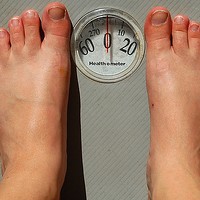Lose Weight > Weight Loss Tips > Weight Loss Articles > How to Tell if Your Belly is Growing Too Fat
How to Tell if Your Belly is Growing Too Fat
Getting a fat belly is particularly unhealthy when compared with gaining fat in other areas of your body. Extra belly fat increases your risk of type 2 diabetes, cardiovascular disease and certain types of cancer.
To tell if your belly is growing too fat and becoming a health risk you want to throw out the scale and pick up a measuring tape. The key to diagnosing whether your belly is growing too fat is to measure your waist-hip ratio (a measurement of the waist size divided by the hip size). To accurately determine your ratio, first measure around your waist at about the level of your belly button; don't hold your stomach in and don't pull the tape so tight that you indent the skin. Next you want to measure around the fullest area of your hips with your feet together. Divide your waist measurement by the measurement at your hips.
A waist-hip ratio above .85 for women and above .90 for men indicates a higher health risk.
Waist Measurement � Hip Measurement = Waist-Hip Ratio
While it is not unusual to gain weight as you age due to a slower metabolism and less activity, a belly growing fat seems to have additional causes. Heredity may be one factor - you may simply have inherited a tendency to get a fat belly. Hormones are also important players for women. Hormones change after menopause and effect the way your body handles fat, depositing greater amounts in the belly.
Even though belly fat tends to be found deeper inside the body than fat that is found around the hips, thighs and butt it is all removed in the same way - through proper diet and exercise.
Related Articles
-
Rapid Weight Loss Diet Programs
There are many varieties of diet programs that promote or claim to
-
Top Secret Fat Loss Secret - Lose Weight Now
Lose Weight Now There are numerous weight loss plans and diets for los
-
The need for a balanced diet for weight loss
Everyone leads a busy life running around to office. One of
-
The RESULTS Diet!
R...real foodE...exerciseS...spiritual stuff first a
-
Do Not Listen To The Exploitive Weight Loss Industry
The exploitive weight loss industry hopes Americans continue to strugg
-
Starting A Diet The Right Way
If youre just starting out on a diet for the first time, there are cer
- DON'T MISS
- Simple Tricks To Get More Protein In Your Diet
- Weight Loss Diet Pills: A Swift Remedy
- True Weight Loss Success Starts With Strength and Growth - Part 2
- Selecting the Best Online Weight Loss Program
- Quick Weight Loss Program: 3 Easy to Follow Steps to Lose Weight Fast but Smart
- Herbal Weight Loss - Some types of herbal weight loss can help you
- Calorie Shifting - How This Fast Diet Method Works
- Coctein - Coconut Water And Whey Protein Miracle
- Everloss - Best Weight Loss Supplements for Real Results!
- How to maintain weight loss during the holidays




